Perspectives of the Friction Mechanism of Hydrogenated Diamond-Like Carbon Film in Air by Varying Sliding Velocity
Abstract
:1. Introduction
2. Materials and Methods
2.1. Preparation of H-DLC Film
2.2. Test Methods
3. Result
3.1. Friction Behavior of the H-DLC Film at Various Sliding Velocities
3.2. Wear Resistance of the H-DLC Film at Different Sliding Velocities
4. Discussion
4.1. Role of Graphitization of DLC Material beneath the Worn Surface in the Velocity-Dependence
4.2. Role of Graphitized Transfer Layer in the Velocity-Dependence
4.3. Role of Surface Passivation in the Velocity-Dependence
5. Conclusions
- The friction coefficient and wear resistance of the H-DLC film strongly depend on the sliding velocity. With the increase of sliding velocity, both the friction coefficient and wear resistance decrease gradually below 400 mm/s and then increase above this critical velocity.
- No significant change of bonding structure is observed on the worn surface of H-DLC film at various sliding velocities that eliminates the graphitization of H-DLC material beneath the worn region contributing to the variation of friction coefficient.
- Both the transfer layer and surface passivation mechanism contribute to the velocity dependence of friction coefficient and wear resistance on the H-DLC film in air. The transfer layer mechanism may dominate the friction behavior at a relatively low sliding velocity, while the passivation mechanism may play a more important role at high sliding velocity.
Author Contributions
Funding
Acknowledgments
Conflicts of Interest
References
- Erdemir, A.; Eryilmaz, O. Achieving superlubricity in DLC films by controlling bulk, surface, and tribochemistry. Friction 2014, 2, 140–155. [Google Scholar] [CrossRef] [Green Version]
- Zahid, R.; Masjuki, H.H.; Varman, M.; Kalam, M.A.; Mufti, R.A.; Mohd Zulkifli, N.W.B.; Gulzar, M.; Nor Azman, S.S.B. Influence of intrinsic and extrinsic conditions on the tribological characteristics of diamond-like carbon coatings: A review. J. Mater. Res. 2016, 31, 1814–1836. [Google Scholar] [CrossRef]
- Zhang, P.; He, H.; Chen, C.; Xiao, C.; Chen, L.; Qian, L. Effect of abrasive particle size on tribochemical wear of monocrystalline silicon. Tribol. Int. 2017, 109, 222–228. [Google Scholar] [CrossRef]
- Muguruma, T.; Iijima, M.; Kawaguchi, M.; Mizoguchi, I. Effects of sp2/sp3 ratio and hydrogen content on in vitro bending and frictional performance of DLC-coated orthodontic stainless steels. Coatings 2018, 8, 199. [Google Scholar] [CrossRef]
- Shi, W.L.; Wei, X.T.; Zhang, W.; Wang, Z.G.; Dong, C.H.; Li, S. Developments and applications of diamond-like carbon. Appl. Mech. Mater. 2017, 864, 14–24. [Google Scholar] [CrossRef]
- Cui, L.; Lu, Z.; Wang, L. Toward low friction in high vacuum for hydrogenated diamondlike carbon by tailoring sliding interface. ACS Appl. Mater. Interfaces 2013, 5, 5889–5893. [Google Scholar] [CrossRef] [PubMed]
- Erdemir, A.; Ramirez, G.; Eryilmaz, O.L.; Narayanan, B.; Liao, Y.; Kamath, G.; Sankaranarayanan, S.K. Carbon-based tribofilms from lubricating oils. Nature 2016, 536, 67–71. [Google Scholar] [CrossRef] [PubMed]
- Wang, F.; Wang, L.; Xue, Q. Fluorine and sulfur co-doped amorphous carbon films to achieve ultra-low friction under high vacuum. Carbon 2016, 96, 411–420. [Google Scholar] [CrossRef]
- Cao, Z.; Zhao, W.; Liu, Q.; Liang, A.; Zhang, J. Super-elasticity and ultralow friction of hydrogenated fullerene-like carbon films: Associated with the size of graphene sheets. Adv. Mater. Interfaces 2018, 5, 1701303. [Google Scholar] [CrossRef]
- Berman, D.; Deshmukh, S.A.; Sankaranarayanan, S.K.; Erdemir, A.; Sumant, A.V. Macroscale superlubricity enabled by graphene nanoscroll formation. Science 2015, 348, 1118–1122. [Google Scholar] [CrossRef] [PubMed] [Green Version]
- Bhowmick, S.; Banerji, A.; Lukitsch, M.J.; Alpas, A.T. The high temperature tribological behavior of Si, O containing hydrogenated diamond-like carbon (a-C:H/a-Si:O) coating against an aluminum alloy. Wear 2015, 330, 261–271. [Google Scholar] [CrossRef]
- Kano, M. Overview of DLC-coated engine components. In Coating Technology for Vehicle Applications, 1st ed.; Cha, S.C., Erdemir, A., Eds.; Springer: Cham, Switzerland, 2015; pp. 37–62. [Google Scholar]
- Chen, Z.; Ren, X.; Ren, L.; Wang, T.; Qi, X.; Yang, Y. Improving the tribological properties of spark-anodized titanium by magnetron sputtered diamond-like carbon. Coatings 2018, 8, 83. [Google Scholar] [CrossRef]
- Shi, J.; Gong, Z.; Wang, C.; Zhang, B.; Zhang, J. Tribological properties of hydrogenated amorphous carbon films in different atmospheres. Diam. Relat. Mater. 2017, 77, 84–91. [Google Scholar] [CrossRef]
- Kim, D.-W.; Kim, K.-W. Effects of sliding velocity and ambient temperature on the friction and wear of a boundary-lubricated, multi-layered DLC coating. Wear 2014, 315, 95–102. [Google Scholar] [CrossRef]
- Solis, J.; Zhao, H.; Wang, C.; Verduzco, J.A.; Bueno, A.S.; Neville, A. Tribological performance of an H-DLC coating prepared by PECVD. Appl. Surf. Sci. 2016, 383, 222–232. [Google Scholar] [CrossRef] [Green Version]
- Ciniero, A.; Le Rouzic, J.; Reddyhoff, T. The use of triboemission imaging and charge measurements to study DLC coating failure. Coatings 2017, 7, 129. [Google Scholar] [CrossRef]
- Li, K.; Zhou, Z.; Bello, I.; Lee, C.S.; Lee, S.T. Study of tribological performance of ECR–CVD diamond-like carbon coatings on steel substrates. Wear 2005, 258, 1577–1588. [Google Scholar] [CrossRef]
- Kim, D.W.; Kim, K.W. Effects of sliding velocity and normal load on friction and wear characteristics of multi-layered diamond-like carbon (DLC) coating prepared by reactive sputtering. Wear 2013, 297, 722–730. [Google Scholar] [CrossRef]
- Kim, H.I.; Lince, J.R.; Eryilmaz, O.L.; Erdemir, A. Environmental effects on the friction of hydrogenated DLC films. Tribol. Lett. 2006, 21, 51–56. [Google Scholar] [CrossRef]
- Cui, L.; Lu, Z.; Wang, L. Probing the low-friction mechanism of diamond-like carbon by varying of sliding velocity and vacuum pressure. Carbon 2014, 66, 259–266. [Google Scholar] [CrossRef]
- Liu, Y.; Yu, B.; Cao, Z.; Shi, P.; Zhou, N.; Zhang, B.; Zhang, J.; Qian, L. Probing superlubricity stability of hydrogenated diamond-like carbon film by varying sliding velocity. Appl. Surf. Sci. 2018, 439, 976–982. [Google Scholar] [CrossRef]
- He, M.; Yeo, C. Evaluation of thermal degradation of DLC Film using a novel Raman spectroscopy technique. Coatings 2018, 8, 143. [Google Scholar] [CrossRef]
- Chen, L.; He, H.; Wang, X.; Kim, S.H.; Qian, L. Tribology of Si/SiO2 in humid air: Transition from severe chemical wear to wearless behavior at nanoscale. Langmuir 2015, 31, 149–156. [Google Scholar] [CrossRef] [PubMed]
- Aghdam, A.B.; Khonsari, M.M. Prediction of wear in reciprocating dry sliding via dissipated energy and temperature rise. Tribol. Lett. 2013, 50, 365–378. [Google Scholar] [CrossRef]
- Zhang, P.; Chen, C.; Xiao, C.; Chen, L.; Qian, L. Comparison of wear methods at nanoscale: Line scanning and area scanning. Wear 2018, 400, 137–143. [Google Scholar] [CrossRef]
- Liu, Y.; Meletis, E.I. Evidence of graphitization of diamond-like carbon films during sliding wear. J. Mater. Sci. 1997, 32, 3491–3495. [Google Scholar] [CrossRef]
- Liu, Y.; Erdemir, A.; Meletis, E.I. An investigation of the relationship between graphitization and frictional behavior of DLC coatings. Surf. Coat. Technol. 1996, 86, 564–568. [Google Scholar] [CrossRef]
- Wang, Y.; Guo, J.; Gao, K.; Zhang, B.; Liang, A.; Zhang, J. Understanding the ultra-low friction behavior of hydrogenated fullerene-like carbon films grown with different flow rates of hydrogen gas. Carbon 2014, 77, 518–524. [Google Scholar] [CrossRef]
- Scharf, T.W.; Singer, I.L. Role of third bodies in friction behavior of diamond-like nanocomposite coatings studied byin situtribometry. Tribol. Trans. 2002, 45, 363–371. [Google Scholar] [CrossRef]
- Manimunda, P.; Al-Azizi, A.; Kim, S.H.; Chromik, R.R. Shear-induced structural changes and origin of ultralow friction of hydrogenated diamond-like carbon (DLC) in dry environment. ACS Appl. Mater. Interfaces 2017, 9, 16704–16714. [Google Scholar] [CrossRef] [PubMed]
- Chen, X.; Kato, T.; Nosaka, M. Origin of superlubricity in a-C:H:Si films: A relation to film bonding structure and environmental molecular characteristic. ACS Appl. Mater. Interfaces 2014, 6, 13389–13405. [Google Scholar] [CrossRef] [PubMed]
- Cui, L.; Lu, Z.; Wang, L. Environmental effect on the load-dependent friction behavior of a diamond-like carbon film. Tribol. Int. 2015, 82, 195–199. [Google Scholar] [CrossRef]
- Al Mahmud, K.A.; Kalam, M.A.; Masjuki, H.H.; Mobarak, H.M.; Zulkifli, N.W. An updated overview of diamond-like carbon coating in tribology. Crit. Rev. Solid State Mater. Sci. 2015, 40, 90–118. [Google Scholar] [CrossRef]
- Casiraghi, C.; Ferrari, A.C.; Robertson, J. Raman spectroscopy of hydrogenated amorphous carbons. Phys. Rev. B 2005, 72, 085401. [Google Scholar] [CrossRef]
- Prawer, S.; Nugent, K.W.; Lifshitz, Y.; Lempert, G.D.; Grossman, E.; Kulik, J.; Avigal, I.; Kalish, R. Systematic variation of the Raman spectra of DLC films as a function of sp2:sp3 composition. Diam. Relat. Mater. 1996, 5, 433–438. [Google Scholar] [CrossRef]
- Song, H.; Ji, L.; Li, H.; Liu, X.; Zhou, H.; Wang, W.; Chen, J. Perspectives of friction mechanism of a-C:H film in vacuum concerning the onion-like carbon transformation at the sliding interface. RSC Adv. 2015, 5, 8904–8911. [Google Scholar] [CrossRef]
- Byrne, C.; Wang, Z. Influence of thermal properties on friction performance of carbon composites. Carbon 2001, 39, 1789–1801. [Google Scholar] [CrossRef]
- Yen, B.K. An investigation of friction and wear mechanisms of carbon-carbon composites in nitrogen and air at elevated temperatures. Carbon 1996, 34, 489–498. [Google Scholar] [CrossRef]
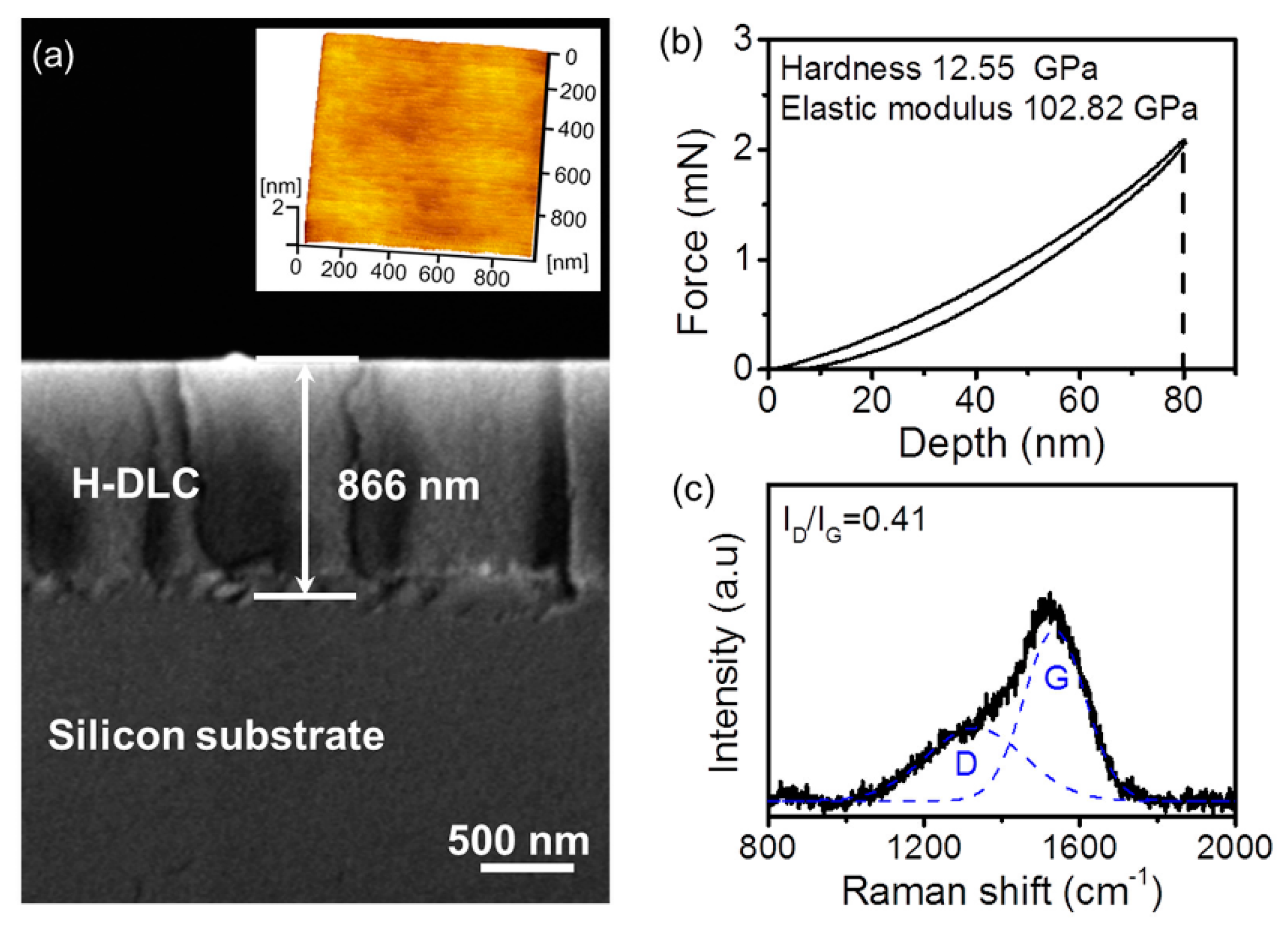
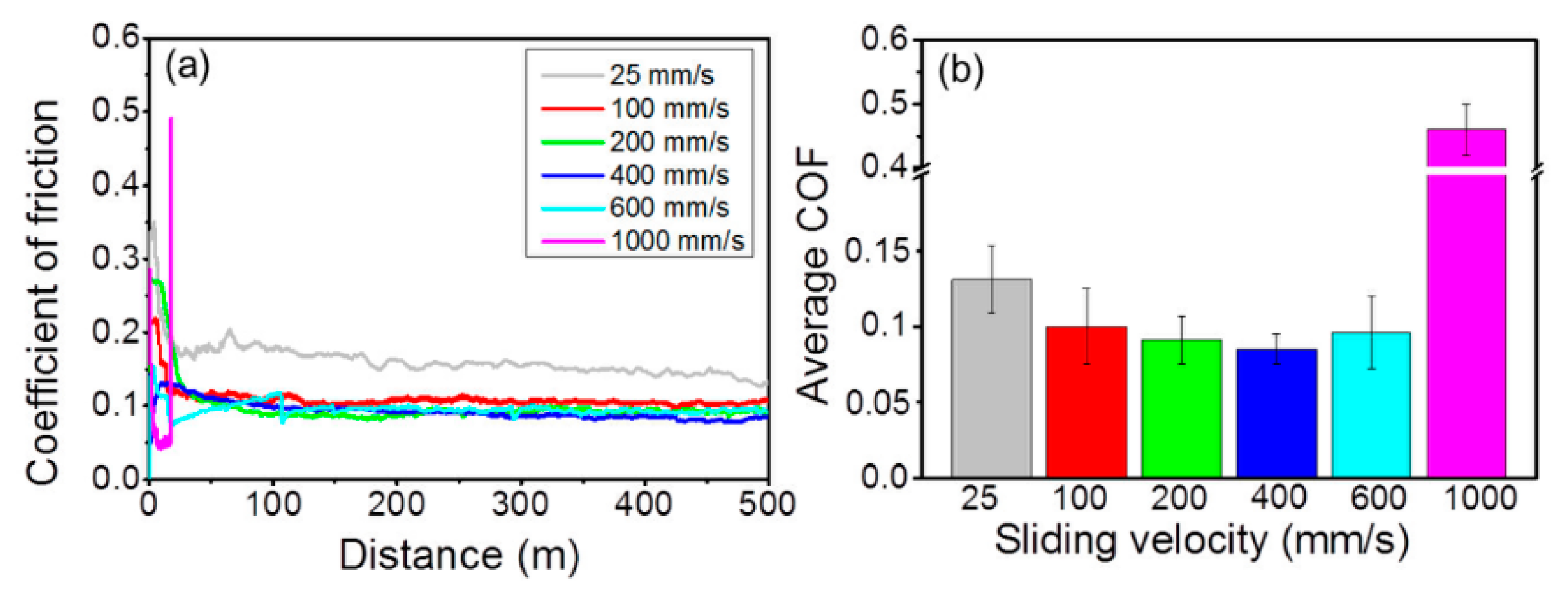


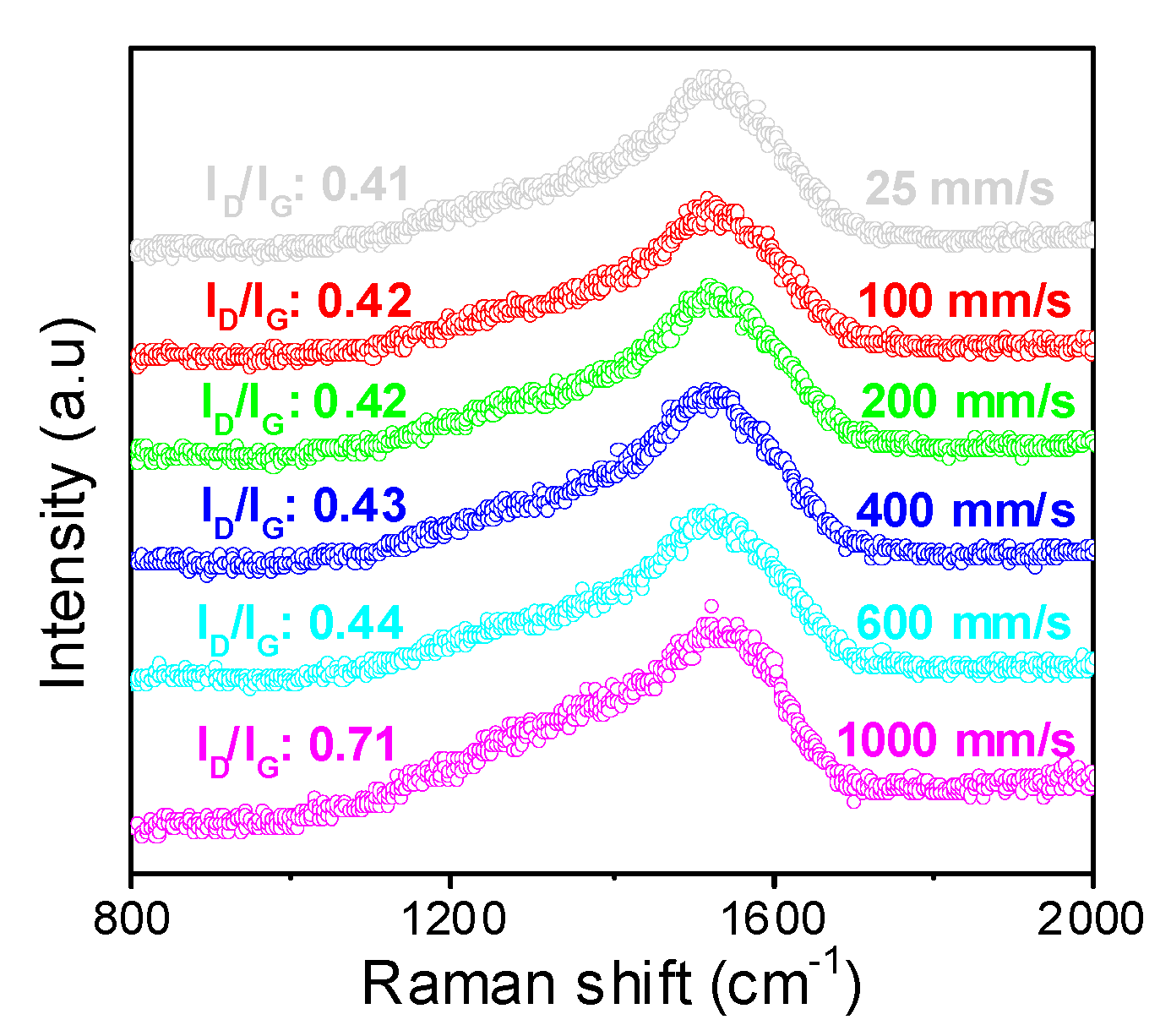
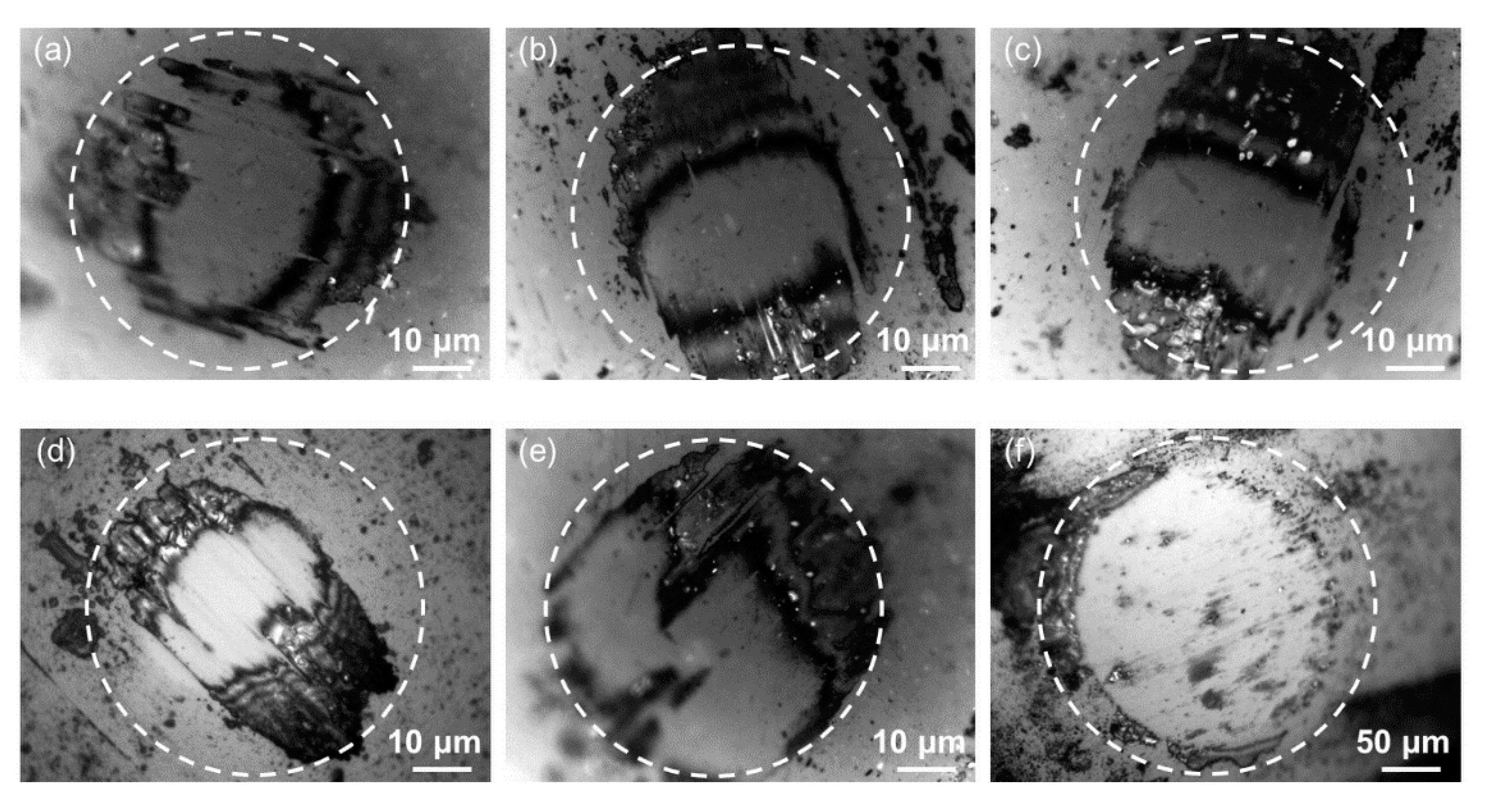
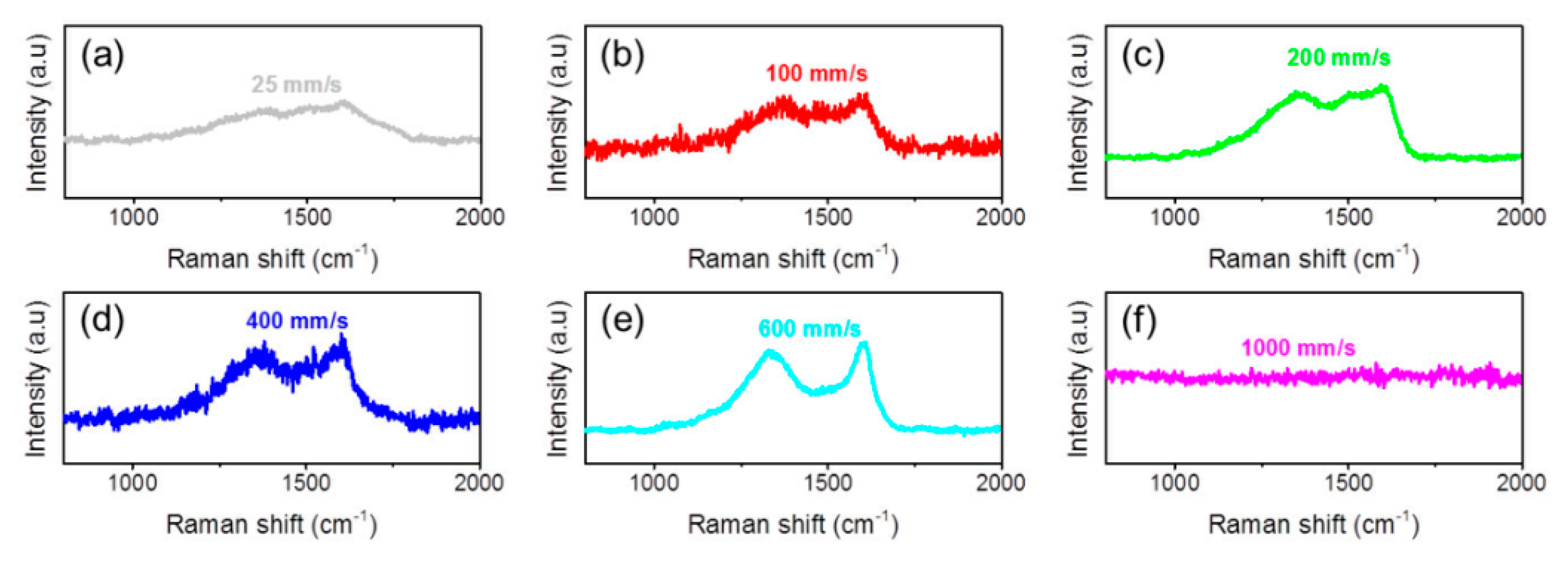
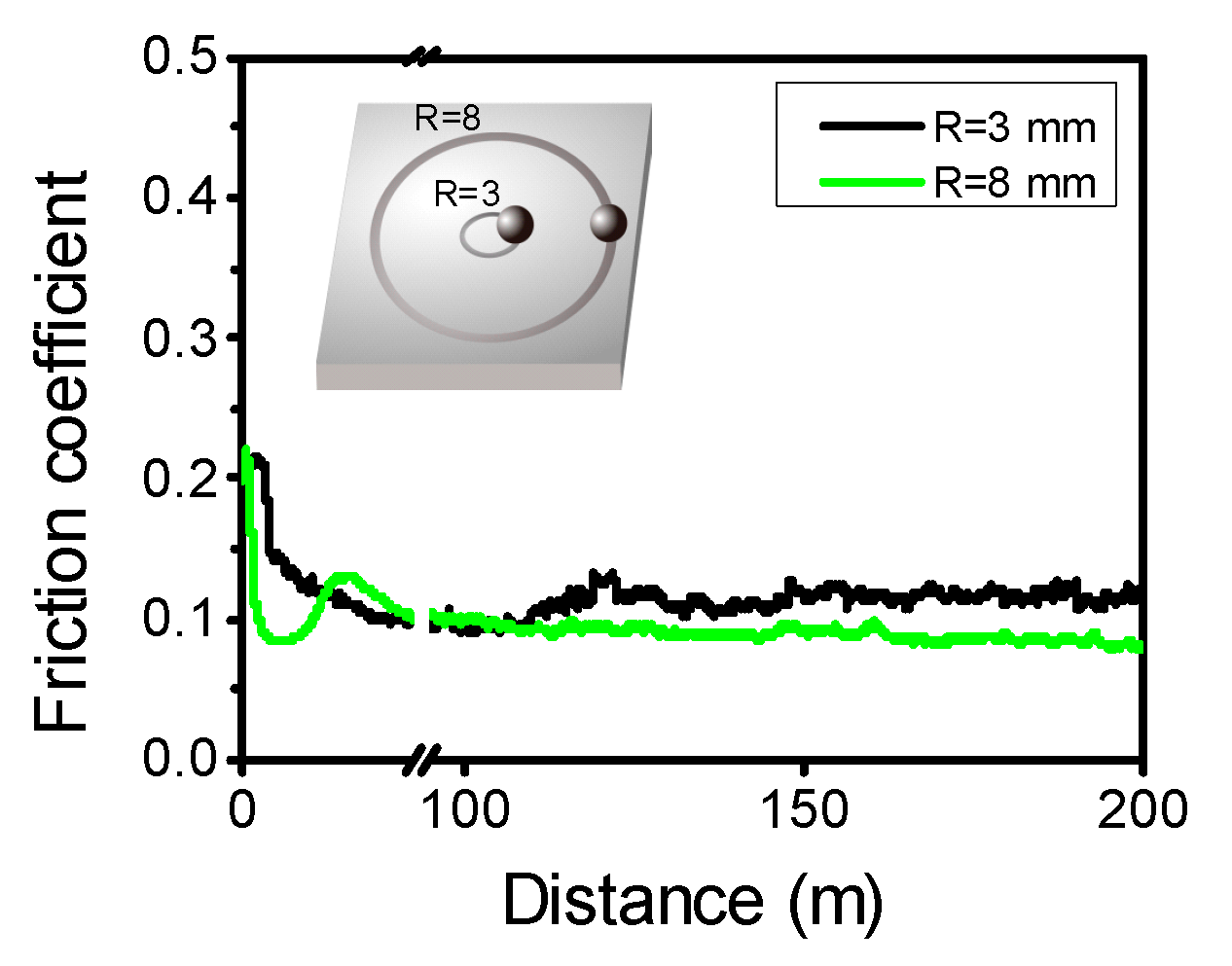
© 2018 by the authors. Licensee MDPI, Basel, Switzerland. This article is an open access article distributed under the terms and conditions of the Creative Commons Attribution (CC BY) license (http://creativecommons.org/licenses/by/4.0/).
Share and Cite
Liu, Y.; Zhang, B.; Chen, L.; Cao, Z.; Shi, P.; Liu, J.; Zhang, J.; Qian, L. Perspectives of the Friction Mechanism of Hydrogenated Diamond-Like Carbon Film in Air by Varying Sliding Velocity. Coatings 2018, 8, 331. https://doi.org/10.3390/coatings8100331
Liu Y, Zhang B, Chen L, Cao Z, Shi P, Liu J, Zhang J, Qian L. Perspectives of the Friction Mechanism of Hydrogenated Diamond-Like Carbon Film in Air by Varying Sliding Velocity. Coatings. 2018; 8(10):331. https://doi.org/10.3390/coatings8100331
Chicago/Turabian StyleLiu, Yunhai, Bin Zhang, Lei Chen, Zhongyue Cao, Pengfei Shi, Jinwei Liu, Junyan Zhang, and Linmao Qian. 2018. "Perspectives of the Friction Mechanism of Hydrogenated Diamond-Like Carbon Film in Air by Varying Sliding Velocity" Coatings 8, no. 10: 331. https://doi.org/10.3390/coatings8100331



